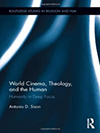- Author(s): Rocco Giansante
- When: 2019-09
- Where: Journal of Religion & Film
Elia Suleiman and Amos Gitai are two Israeli filmmakers, Palestinian and Jewish respectively. Gitai’s first film, House (1980), was censored by Israeli Television—the producers of the film—due to its sympathetic portrayal of Palestinians. Elia Suleiman’s debut film, Chronicle of a Disappearance (1996), was criticized at the Carthage Film Festival in Tunisia for a sequence showing an Israeli flag and Suleiman himself was accused of being a Zionist collaborator. By comparing the ways in which these two films deal with the political and social implications of the Israel-Palestine conflict, this article highlights two distinct methods of relating to facts on the ground: the topological and the temporal. While Gitai, the architect-turned-film maker, focuses on the former, building his film around a house inhabited by the Arab workers who are renovating it, Suleiman develops his film along a temporal axis marked by the chapters of his chronicle.







